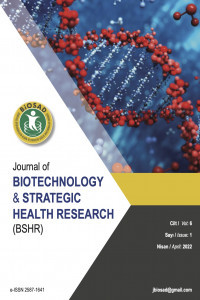Diş Hekimliği Öğrencilerinin Covid-19 Pandemisi ile İlgili Bilgi Düzeylerinin Değerlendirilmesi
Covid-19, diş hekimliği öğrencileri, enfeksiyon, inkübasyon periyodu
Evaluation of Information Levels of Dentistry Students About Covid-19 Pandemic
Covid-19, dental student, infection, incubation period,
___
- Spagnuolo G, De Vito D, Rengo S, et al. COVID-19 Outbreak: An Overview on Dentistry. Int J Environ Res Public Health. 2020;17: 2094.
- Yılmaz D. COVID-19 ve Dis Hekimliği. J Biotechnol and Strategic Health Res. 2020;1:22-28.
- Zhou P, Yang XL, Wang XG, et al. A pneumonia outbreak associated with a new coronavirus of probable bat origin. Nature. 2020;579:270–273.
- Liu P, Chen W, Chen JP. Viral Metagenomics Revealed Sendai Virus and Coronavirus Infection of Malayan Pangolins. Viruses. 2019;11: 979.
- Li ZY, Meng LY. Prevention and control of new coronavirus infection in department of stomatology. Chin J Stomatol. 2020;9:217-222.
- Meng L, Hua F, Bian Z. Coronavirus Disease 2019 (COVID-19): Emerging and Future Challenges for Dental and Oral Medicine. J Dent Res. 2020;99: 481-487.
- Wan Y, Shang J, Graham R, et al. Receptor Recognition by the Novel Coronavirus from Wuhan: an Analysis Based on Decade-Long Structural Studies of SARS Coronavirus. J Virol. 2020;94:127-220.
- Zou X, Chen K, Zou J, et al. Single-cell RNA-seq data analysis on the receptor ACE2 expression reveals the potential risk of different human organs vulnerable to 2019-nCoV infection. Front Me. 2020;10.
- To KK, Tsang OT, Chik-Yan Yip C, et al. Consistent detection of 2019 novel coronavirus in saliva. Clin Infect Dis. 2020;149.
- Khader Y, Nsour MA, Al-Batayneh OB, et al. Dentists’ Awareness, Perception, and Attitude Regarding COVID-19 and Infection Control: Cross-Sectional Study Among Jordanian Dentists. JMIR Public Health Surveill. 2020;6:1.
- Ahmed MA, Jouhar R, Ahmed N, Adnan S, et al. Fear and Practice Modifications among Dentists toCombat Novel Coronavirus Disease (COVID-19) Outbreak 7 Int J Environ Res Public Health. 2020;7:2821-2822.
- Barabari P, Moharamzadeh K. Novel Coronavirus (COVID-19) and Dentistry–A Comprehensive Review of Literature. Dent J. 2020; 8:53-57.
- Peng X, Xu X, Li Y, et al. Transmission routes of 2019-nCoV and controls in dental practice. Int J Oral Sci. 20201;2:9.
- Backer JA, Klinkenberg D, Wallinga J. Incubation period of 2019 novel coronavirus (2019-nCoV) infections amongtravellers from Wuhan, China, 2020;25:5.
- Cagetti MG, CairoliJL, Senna A, et al. COVID-19 Outbreak in North Italy: An Overview on Dentistry. A Questionnaire Survey. Int J Environ Res Public Health. 2020;17: 3835.
- Ge Z, Yang L, Xia J, et al. Possible aerosol transmission of COVID-19 and special precautionsin dentistry. J. Zhejiang Univ B. 2020;1–8.
- Wu Z, McGoogan JM. Characteristics of and important lessons from the coronavirus disease 2019 (COVID-19) outbreak in China: Summary of a report of 72314 cases from the chinese center for diseasecontrol and prevention. JAMA J Am Med Assoc. 2020;323:1239–1242.
- Chen WH, Strych U, Hotez PJ, et al. The SARS-CoV-2 vaccine pipeline: An overview. Curr Trop Med Rep. 2020;3:1–4.
- Duruk G, Gümüşboğa ZŞ, Çolak C. Investigation of Turkish dentists’ clinical attitudes and behaviors towards the COVID-19 pandemic: a survey study. Braz Oral Res. 2020;34:54-70.
- Wei, J.; Li, Y. Airborne spread of infectious agents in the indoor environment. Am J Infect Control. 2016;44:102–108.
- Ye Z, Zhang Y, Wang,Y, Huang Z, et al. Chest CT manifestations of new coronavirus disease 2019 (COVID-19): A pictorial review. Eur Radiol. 2020 in press.
- Briefing: Coronavirus (COVID-19) Testing ABPI. Available online: https://www.abpi.org.uk/medicinediscovery/covid-19/briefing-coronavirus-covid-19-testing/ (accessed on 9 April 2020)
- Yayın Aralığı: Yılda 3 Sayı
- Başlangıç: 2017
- Yayıncı: Deneysel, Biyoteknolojik, Klinik ve Stratejik Sağlık Araştırmaları Derneği
Gülnur TARHAN, Gülfer YAKICI, Begüm KAYAR, Sadık AKGÜN, Fatih KÖKSAL
İnfluenza Tanısında Kullanlılan Hızlı Tanı Kitlerinin RT-PCR yöntemi ile Karşılaştırılması
Ayşe Başak ALTAŞ, Yasemin COSGUN, Fatma BAYRAKDAR, Gülay KORUKLUOĞLU, Selçuk KILIÇ
Hasta Kan Yönetimi; Neden, Nereden Ve Nasıl Başlamalıyız?
Merve PİLAVCI ADIGÜL, Eyüp ERDOĞAN, Selma ALTINDİŞ, Ayça TAŞ TUNA
Kurkumin ve Gastrointestinal Sistem Hastalıkları
Esra Tansu SARIYER, Burcu Merve AKSU
Akut Gastroenteritli Hastalarda İnsan Bokavirüsün Moleküler Yöntem ile Araştırılması
Fadime KAHYAOĞLU, Sevin KIRDAR
Emine PARLAK, Fatma KESMEZ CAN, Handan ALAY, Mehmet PARLAK, Zülal ÖZKURT, Zahide KOŞAN
Klinik Uygulamalarda Süreç Yönetimi
COVID-19 Hastasında Tosilizumab Kullanımı Sonrası Gelişen Karaciğer Toksisitesi
Erkut ETÇİOĞLU, Deniz ÇEKİÇ, Kubilay İŞSEVER, Ahmed Cihad GENÇ, Abdülkadir AYDIN, Selcuk YAYLACI
